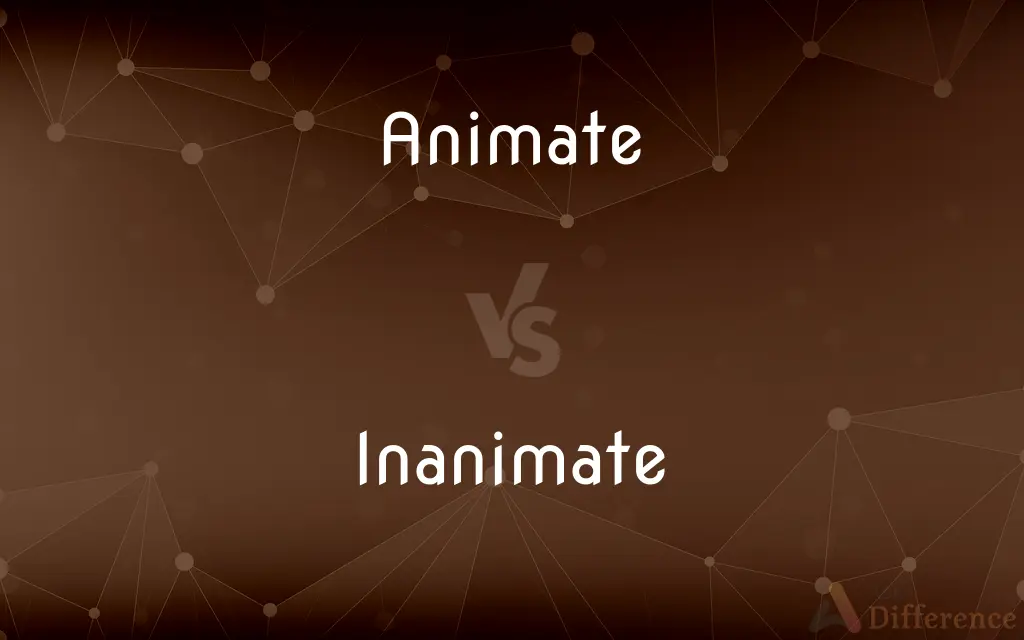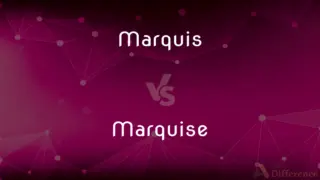Animate vs. Inanimate — What's the Difference?
By Tayyaba Rehman — Updated on November 2, 2023
Animate pertains to things that are alive and have movement; inanimate refers to objects without life or motion.

Difference Between Animate and Inanimate
Table of Contents
ADVERTISEMENT
Key Differences
Animate objects possess the quality of life and are capable of voluntary movement or action. This term is derived from the Latin "animatus," meaning "to give life to." Animate entities are often subjects of biological and ecological studies due to their vital processes and ability to reproduce.
In contrast, inanimate objects do not have life and cannot move on their own. They are characterized by a lack of consciousness and biological activity. Inanimate is often used to describe objects that are involved in physical and chemical studies due to their static nature.
Each animate entity is typically associated with growth, metabolism, responsiveness to stimuli, and reproduction. These are the hallmarks of life that separate animate from inanimate entities. The animate category spans a vast array of life forms, from single-celled organisms to complex beings like humans.
On the other hand, inanimate objects can encompass a wide range of items, from rocks and minerals to man-made objects like chairs and computers. Despite not possessing life, inanimate objects play crucial roles in the lives of animate beings and the functioning of ecosystems.
The animate and inanimate distinction is fundamental to understanding the composition of the world around us. It shapes our interactions with our environment, informing everything from ethical considerations to technological advancements.
ADVERTISEMENT
Comparison Chart
Life
Possesses life
Lacks life
Movement
Can move voluntarily
Cannot move by itself
Biology
Undergoes biological processes
Does not have biological processes
Reaction to Stimuli
Responsive
Non-responsive
Growth
Capable of growth and reproduction
Does not grow or reproduce
Compare with Definitions
Animate
Endowed with life.
Birds are animate beings that fascinate with their flight.
Inanimate
Not alive.
Rocks are inanimate, yet they form the backbone of our planet's structure.
Animate
To make lively.
The speaker could animate the crowd with his powerful words.
Inanimate
Not capable of movement.
The inanimate sculpture stood silent in the gallery.
Animate
To move or stir to action.
A good leader can animate their team to achieve great results.
Inanimate
Devoid of life or spirit.
The abandoned town seemed eerily inanimate at night.
Animate
Possessing the quality of life.
The animate nature of pets brings joy to many homes.
Inanimate
Without the power of action.
The inanimate machines waited for the factory to come to life.
Animate
To give spirit and support.
The cheerleaders animate the team's spirit during games.
Inanimate
Not having the qualities associated with active, living organisms.
Animate
To give life to; fill with life
The belief that the soul animates the body.
Inanimate
Not animated or energetic; dull.
Animate
To impart interest or zest to; enliven
"voices animated by food, drink, and company" (Anita Desai).
Inanimate
(Grammar) Belonging to the class of nouns that stand for nonliving things
The word car is inanimate.
The word dog is animate.
Animate
To fill with spirit, courage, or resolution
"a wave of exploratory voyages animated by a spirit of scientific inquiry" (Lincoln P. Paine).
Inanimate
Lacking the quality or ability of motion; as an inanimate object.
Animate
To inspire to action; prompt
"The merest whisper of Bothwell's death was enough to animate Mary's supporters on the Continent" (John Guy).
Inanimate
Not being, and never having been alive, especially not like humans and animals.
Animate
To impart motion or activity to
The wind animated the surface of the lake.
Inanimate
(grammar) Not animate.
Animate
To make or depict using animation
Animate a children's bedtime story.
Inanimate
(rare) Something that is not alive.
Animate
Possessing life; living.
Inanimate
(obsolete) To animate.
Animate
Of or relating to animal life as distinct from plant life.
Inanimate
To animate.
Animate
Belonging to the class of nouns that stand for living things
The word dog is animate.
The word car is inanimate.
Inanimate
Not animate; destitute of life or spirit; lifeless; dead; inactive; dull; as, stones and earth are inanimate substances.
Grieving, if aught inanimate e'er grieves.
Animate
Frequently moving; active or vigorous
A bird with an animate tail.
Inanimate
Belonging to the class of nouns denoting nonliving things;
The word `car' is inanimate
Animate
That which lives.
Inanimate
Not endowed with life;
The inorganic world is inanimate
Inanimate objects
Dead stones
Animate
Possessing the quality or ability of motion.
Inanimate
Appearing dead; not breathing or having no perceptible pulse;
An inanimate body
Pulseless and dead
Animate
Dynamic, energetic.
She is an engaging and animate speaker.
Inanimate
Lacking consciousness.
The inanimate doll lay forgotten in the attic.
Animate
Having a referent that is considered alive (this generally includes humans and animals, often also gods, plants, etc.)
Nouns can be singular or plural, and one of two genders, animate or inanimate.
Animate
(grammar) Inflected to agree with an animate noun or pronoun.
Animate
(transitive) To impart motion or the appearance of motion to.
If we animate the model, we can see the complexity of the action.
Animate
(transitive) To give spirit or vigour to; to stimulate or enliven; to inspirit.
Animate
To give natural life to; to make alive; to quicken; as, the soul animates the body.
Animate
To give powers to, or to heighten the powers or effect of; as, to animate a lyre.
Animate
To give spirit or vigor to; to stimulate or incite; to inspirit; to rouse; to enliven.
The more to animate the people, he stood on high . . . and cried unto them with a loud voice.
Animate
Endowed with life; alive; living; animated; lively.
The admirable structure of animate bodies.
Animate
Heighten or intensify;
These paintings exalt the imagination
Animate
Give life-like qualities to;
Animated cartoons
Animate
Make lively;
Let's liven up this room a bit
Animate
Give new life or energy to;
A hot soup will revive me
This will renovate my spirits
This treatment repaired my health
Animate
Belonging to the class of nouns that denote living beings;
The word `dog' is animate
Animate
Endowed with animal life as distinguished from plant life;
We are animate beings
Animate
Endowed with feeling and unstructured consciousness;
The living knew themselves just sentient puppets on God's stage
Common Curiosities
What defines an object as animate?
Being alive and capable of moving independently.
Are plants considered animate?
Yes, plants are animate as they are living organisms.
Do children learn the difference between animate and inanimate early?
Yes, children often grasp the concept at a young age.
Are viruses considered animate or inanimate?
Viruses are often debated upon, but generally are not considered fully animate as they cannot reproduce without a host.
Are computers animate?
No, despite their complexity, computers are inanimate.
Is the term animate related to animation?
Yes, animation refers to the process of making inanimate objects appear to move.
Can inanimate objects become animate?
No, inanimate objects cannot become alive.
Is water animate or inanimate?
Water is inanimate as it does not have life.
Can inanimate objects have energy?
Yes, they can contain physical energy but are not alive.
Does the study of animate things include psychology?
Yes, psychology studies the behavior of animate beings, particularly humans and animals.
Are all moving objects animate?
No, movement alone does not imply life; wind can move inanimate objects like leaves.
Are robots animate?
No, robots are inanimate, although they can mimic animate movements.
Can animate beings interact with inanimate objects?
Yes, animate beings use and interact with inanimate objects regularly.
Does inanimate matter have a role in the ecosystem?
Yes, inanimate matter like water, minerals, and rocks are essential to ecosystems.
Can art depict both animate and inanimate subjects?
Yes, art can represent both living beings and non-living objects.
Share Your Discovery

Previous Comparison
Heap vs. Pile
Next Comparison
Marquis vs. MarquiseAuthor Spotlight
Written by
Tayyaba RehmanTayyaba Rehman is a distinguished writer, currently serving as a primary contributor to askdifference.com. As a researcher in semantics and etymology, Tayyaba's passion for the complexity of languages and their distinctions has found a perfect home on the platform. Tayyaba delves into the intricacies of language, distinguishing between commonly confused words and phrases, thereby providing clarity for readers worldwide.
















































